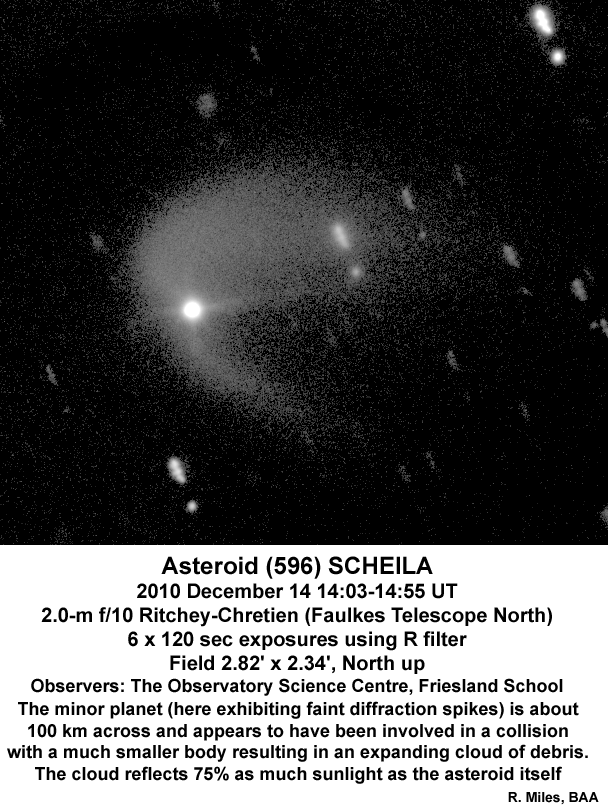Electronic Telegram No. 2632Central Bureau for Astronomical
TelegramsINTERNATIONAL ASTRONOMICAL UNIONCBAT Director: Daniel W. E.
Green; Hoffman Lab 209; Harvard University; 20 Oxford St.; Cambridge, MA
02138; U.S.A.e-mail: cbatiau@eps.harvard.edu [mailto:cbatiau@eps.harvard.edu] (alternatecbat@iau.org [mailto:cbat@iau.org] )URL http://www.cbat.eps.harvard.edu/index.htmlPrepared
using the Tamkin Foundation Computer Network
(596) SCHEILA
E. S.
Howell, Arecibo Observatory, Cornell University; and A. J. Lovell,
Agnes
Scott College, report that observations with the Arecibo Observatory
obtained
on six nights between 2010 Dec. 14 and 2011 Jan. 4 show no clear
detection of
the 1667-MHz line of OH in the coma of (596), currently in
outburst (cf. IAUC
9188). The 3-sigma upper limit of the line strength is 0.90
mJy km/s, which
corresponds to production rates of log Q(OH) = 26.31
(Despois. et al. 1981,
Astron. Astrophys. 99, 320-340) or logQ(OH) = 26.30
(Schleicher and A'Hearn
1988, Ap.J. 331, 1058-1077).
E. Jehin, J. Manfroid, D. Hutsemekers, M.
Gillon, and P. Magain, Fonds
National de la Recherche Scientifique, Liege
University, report on broad- and
narrow-band imaging of the (596) Scheila
outburst (CBET 2583) with the
TRAPPIST 0.60-m telescope at La Silla, and on
optical spectroscopy with the
European Southern Observatory's Very Large
Telescope (VLT) at Paranal. R-band
imaging from 2010 Dec. 12.3 to 21.3 UT
revealed two arc-like coma features
expanding at a regular pace. The first
such feature was 1' long on 2010 Dec.
12, oriented to the northeast and
bending to p.a. 280 deg (the anti-solar
direction). The second feature was
shorter, 30" on Dec. 12, oriented to the
south and bending to p.a. 230 deg.
Both features were getting larger and
fainter with time (4' and 2' long,
respectively, on Dec. 21.3). A narrow
45"-long tail, opposite the sun (p.a.
280 deg), was also observed in good
seeing. R-band images taken on 2011 Jan.
4.3 and 5.3 after the full moon
allowed Jehin et al. to again observe these
features, seen as 7' and 4' long,
respectively -- and much fainter. This
discards any sustained activity of
the minor planet. Narrow-band images
obtained on 2010 Dec. 12.3 with
cometary filters do not show any contribution
from gases. A 20-min optical
spectrum was obtained with FORS2 at the VLT on
Dec. 13.3; it does not show
any extended cometary gaseous emissions, but only
a spatially extended
continuum due to dust-scattered sunlight. Short B, V,
R, and I exposures
performed nearly every two nights from 2010 Dec. 12.3 to
2011 Jan. 5.3 give
a magnitude for the nuclear condensation of V = 14.2 +/-
0.1 over the whole
period, in agreement with the "APmag" value reported in
the Jet Propulsion
Laboratory ephemeris. No flux variation of the nuclear
condensation was
observed. Those preliminary results are in favor of a
collisional scenario
to explain the outburst of (596) Scheila, rather than a
cometary driven
activity. This case might be similar to the outburst of
comet P/2010 A2,
which may have resulted from an impact of a minor planet
(Snodgrass 2010,
Nature 467, 814).
NOTE: These 'Central Bureau
Electronic Telegrams' are sometimes
superseded by text appearing later
in the printed IAU Circulars.
(C) Copyright 2011 CBAT
2011 January
12
(CBET
2632)
Daniel W. E. Green
Speed : 0.26"/min, Diam. coma : +/- 2', PA +/- : 20, 190, 240, 280 et 340









